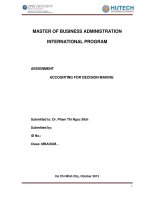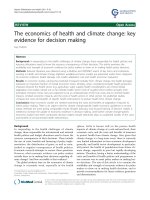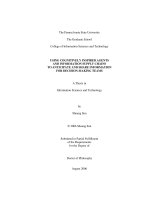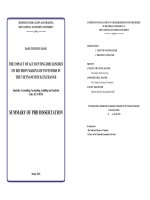Accounting For Managers - Interpreting Accounting Information For Decision Making (Wiley-2003) pdf
Bạn đang xem bản rút gọn của tài liệu. Xem và tải ngay bản đầy đủ của tài liệu tại đây (2.11 MB, 496 trang )
Accounting for Managers:
Interpreting
accounting information
for decision-making
Paul M. Collier
Aston Business School, Aston University
Accounting for Managers
Accounting for Managers:
Interpreting
accounting information
for decision-making
Paul M. Collier
Aston Business School, Aston University
Copyright 2003 John Wiley & Sons Ltd, The Atrium, Southern Gate, Chichester,
West Sussex PO19 8SQ, England
Telephone (+44) 1243 779777
Email (for orders and customer service enquiries):
Visit our Home Page on www.wileyeurope.com or www.wiley.com
All Rights Reserved. No part of this publication may be reproduced, stored in a retrieval system
or transmitted in any form or by any means, electronic, mechanical, photocopying, recording,
scanning or otherwise, except under the terms of the Copyright, Designs and Patents Act 1988
or under the terms of a licence issued by the Copyright Licensing Agency Ltd, 90 Tottenham
Court Road, London W1T 4LP, UK, without the permission in writing of the Publisher.
Requests to the Publisher should be addressed to the Permissions Department, John Wiley &
Sons Ltd, The Atrium, Southern Gate, Chichester, West Sussex PO19 8SQ, England, or emailed
to , or faxed to (+44) 1243 770620.
This publication is designed to provide accurate and authoritative information in regard to the
subject matter covered. It is sold on the understanding that the Publisher is not engaged in
rendering professional services. If professional advice or other expert assistance is required, the
services of a competent professional should be sought.
Other Wiley Editorial Offices
John Wiley & Sons Inc., 111 River Street, Hoboken, NJ 07030, USA
Jossey-Bass, 989 Market Street, San Francisco, CA 94103-1741, USA
Wiley-VCH Verlag GmbH, Boschstr. 12, D-69469 Weinheim, Germany
John Wiley & Sons Australia Ltd, 33 Park Road, Milton, Queensland 4064, Australia
John Wiley & Sons (Asia) Pte Ltd, 2 Clementi Loop #02-01, Jin Xing Distripark, Singapore 129809
John Wiley & Sons Canada Ltd, 22 Worcester Road, Etobicoke, Ontario, Canada M9W 1L1
Wiley also publishes its books in a variety of electronic formats. Some content that appears
in print may not be available in electronic books.
Library of Congress Cataloging-in-Publication Data
Collier, Paul M.
Accounting for managers : interpreting accounting information for decision-making / Paul
M. Collier.
p. cm.
Includes bibliographical references and index.
ISBN 0-470-84502-3 (pbk. : alk. paper)
1. Managerial accounting. I. Title.
HF5657.4 .C647 2003
658.15’11 dc21 2002193369
British Library Cataloguing in Publication Data
A catalogue record for this book is available from the British Library
ISBN 0-470-84502-3
Typeset in 10/12pt Palatino by Laserwords Private Limited, Chennai, India
Printed and bound in Great Britain by Antony Rowe Ltd, Chippenham, Wiltshire
This book is printed on acid-free paper responsibly manufactured from sustainable forestry
in which at least two trees are planted for each one used for paper production.
For Loredana and Alexis
Contents
Preface xiii
Acknowledgements xvii
About the Author xix
PART I
Context of Accounting
1
1 Introduction to Accounting 3
Accounting, accountability and the account 3
A short history of accounting 5
The role of management accounting 6
Recent developments in management accounting 9
A critical perspective 10
Conclusion 11
References 12
2 Accounting and its Relationship to Shareholder Value and Business
Structure 13
Capital and product markets 13
Value-based management 14
Accounting and strategy 17
Structure of business organizations 19
A critical perspective 21
Conclusion 23
References 23
viii ACCOUNTING FOR MANAGERS
3 Recording Financial Transactions and the Limitations
of Accounting 25
Business events, transactions and the accounting system 25
The double entry: recording transactions 27
Extracting financial information from the accounting system 29
Principles and limitations of accounting 31
Cost terms and concepts 34
Conclusion 35
References 35
4 Management Control, Management Accounting and its
Rational-Economic Assumptions 37
Management control systems 37
Management planning and control systems and management accounting 42
Non-financial performance measurement 43
Strategic management accounting 47
A theoretical framework for management accounting 49
Conclusion 51
References 51
5 Interpretive and Critical Perspectives on Accounting and
Decision-Making 55
Alternative paradigms 55
The interpretive paradigm and the social construction perspective 59
Culture, control and accounting 60
The radical paradigm and critical accounting 61
Power and accounting 62
Conclusion 63
References 64
6 Constructing Financial Statements and the Framework
of Accounting 67
Financial accounting 67
Reporting profitability 69
Reporting financial position 70
Accruals accounting 72
Depreciation 73
Reporting cash flow 74
Working capital 75
Managing debtors 76
Managing stock 77
Managing creditors 77
CONTENTS ix
A theoretical perspective on financial statements 78
Agency theory 78
Conclusion 79
References 79
PART II
Using Accounting Information for Decision-Making, Planning
and Control
81
7 Interpreting Financial Statements and Alternative Theoretical
Perspectives 83
Interpreting financial statements 83
Ratio analysis 84
Profitability 84
Liquidity 85
Gearing 85
Activity/efficiency 86
Shareholder return 87
Interpreting financial information using ratios 88
Case study: Ottakar’s – interpreting financial statements 90
Alternative theoretical perspectives on financial statements 94
Social and environmental reporting 94
Intellectual capital 96
Institutional theory 96
Case study: Carrington Printers – an accounting critique 97
Creative accounting and ethics 99
Conclusion 100
References 101
8 Marketing Decisions 103
Marketing strategy 103
Cost behaviour 105
Cost–volume–profit analysis 106
Alternative approaches to pricing 111
Cost-plus pricing 111
Target rate of return pricing 112
Optimum selling price 112
Special pricing decisions 113
Transfer pricing 115
Segmental profitability 115
Case study: Retail Stores PLC – the loss-making division 117
Case study: SuperTech – using accounting information to win sales 119
x ACCOUNTING FOR MANAGERS
Conclusion 120
References 120
9 Operating Decisions 121
The operations function 121
Managing operations – manufacturing 122
Managing operations – services 125
Accounting for the cost of spare capacity 126
Capacity utilization and product mix 127
Theory of Constraints 128
Operating decisions: relevant costs 129
Make versus buy? 130
Equipment replacement 131
Relevant cost of materials 131
Other costing approaches 133
Total quality management 135
Cost of quality 136
Case study: Quality Printing Company – pricing for capacity
utilization 137
Case study: Vehicle Parts Co. – the effect of equipment replacement
on costs and prices 138
Conclusion 140
References 140
10 Human Resource Decisions 141
The cost of labour 142
Relevant cost of labour 144
Business processes and activity-based costs 146
Case study: The Database Management Company – labour costs and
unused capacity 148
Case study: Trojan Sales – the cost of losing a customer 151
Conclusion 152
References 152
11 Accounting Decisions 155
Cost classification 155
Calculating product/service costs 158
Shifts in management accounting thinking 159
Alternative methods of overhead allocation 161
Contingency theory 170
International comparisons 171
Management accounting in Japan 171
Behavioural implications of management accounting 173
CONTENTS xi
Case study: Quality Bank – the overhead allocation problem 176
Conclusion 178
References 178
12 Strategic Investment Decisions 181
Strategy 181
Investment appraisal 182
Accounting rate of return 184
Payback 186
Case study: Goliath Co. – investment evaluation 189
Conclusion: a critical perspective 191
References 192
Appendix: Present value factors 193
13 Performance Evaluation of Business Units 195
The decentralized organization and divisional performance
measurement 195
Return on investment 196
Residual income 197
Controllability 198
Case study: Majestic Services – divisional performance measurement 199
Transfer pricing 201
Transaction cost economics 203
Conclusion: a critical perspective 205
References 206
14 Budgeting 207
What is budgeting? 207
The budgeting process 209
Retail budget example: Sports Stores Co-operative Ltd 213
Manufacturing budget example: Telcon Manufacturing 214
Cash forecasting 216
Cash forecasting example: Retail News Group 217
Theoretical perspectives on budgeting 219
Case study: Svenska Handelsbanken – is budgeting necessary? 222
Conclusion 223
References 223
15 Budgetary Control 225
What is budgetary control? 225
Flexible budgeting 226
Variance analysis 227
xii ACCOUNTING FOR MANAGERS
Variance analysis example: Wood’s Furniture Co. 228
Reconciling the variances 237
Criticism of variance analysis 238
Cost control 240
Conclusion 242
References 242
PART III
Supporting Information
245
16 Research in Management Accounting, Conclusions and Further
Reading 247
Research and theory in management accounting 247
Conclusion: revisiting the rationale 250
References 251
Further reading 251
17 Introduction to the Readings 253
A Cooper and Kaplan (1988). How cost accounting distorts product
costs 255
B Otley, Broadbent and Berry (1995). Research in management
control: An overview of its development 271
C Covaleski, Dirsmith and Samuel (1996). Managerial accounting
research: The contributions of organizational and sociological
theories 293
D Dent (1991). Accounting and organizational cultures: A field study
of the emergence of a new organizational reality 331
Glossary of Accounting Terms 369
Appendices: Questions and Case Studies 381
Appendix 1: Questions 383
Appendix 2: Solutions to Questions 407
Appendix 3: Case Studies 443
Appendix 4: Solutions to Case Studies 457
Author Index 467
Subject Index 469
Preface
Rationale for the book
This book was motivated by the author’s experience in teaching accounting at
postgraduate level (MBA and MSc) at Aston Business School and in-house training
provided for non-financial managers in many organizations to introduce them to
the use of financial tools and techniques.
My own education as an accountant was aimed at achieving professional recog-
nition and emphasized an uncritical acceptance of the tools and techniques that
I was taught. It was only after moving from financial to a general management
position in industry that I began to see the limitations and questionable assump-
tions that underlay these tools and techniques. When I returned to study later in
my career, I was exposed for the first time to alternative paradigms from which to
view accounting. This book is therefore as much a result of my practical experience
as a producer and user of accounting information as it is a result of my teaching
and training experience.
As accounting increasingly becomes decentred from the accounting department
in organizations, line managers in all functional areas of business are expected
to be able to prepare budgets, develop business cases for capital investment,
and exercise cost control to ensure that profit targets are achieved. Managers are
also expected to be able to analyse and interpret accounting information so that
marketing, operations and human resource decisions are made in the light of an
understanding of the financial implications of those decisions.
I was disappointed by the books available to support teaching and training
because most books on accounting have a similar format that is accounting-centric:
chapters typically cover accounting techniques rather than the types of decisions
made by non-financial managers. The emphasis in those books, many of which
are designed for people whose career aspirations are to become accountants, is on
doing accounting rather than using accounting. This book has been written for the
vast majority of postgraduate students and practising managers who do not want
to become professional accountants. The book therefore has a practitioner-manager
orientation.
The title of the book, Accounting for Managers: Interpreting Financial Information
for Decision-Making, emphasizes the focus on accounting to meet the needs of
xiv ACCOUNTING FOR MANAGERS
managers. The material contained in the book stresses the interpretation (rather
than the construction) of accounting information as well as a critical (rather
than unthinking) acceptance of the underlying assumptions behind accounting.
It is suitable for postgraduate and undergraduate students who are undertaking
courses in accounting that do not lead to professional accreditation, and to
practising non-financial managers who need a better understanding of the role of
accounting in their organizations.
There is a focus in most accounting books on manufacturing organizations,
perhaps because many of those books have been issued as revised editions
for many years and have not adequately reflected the changing nature of the
economies in the developed world. The growth of service businesses and the
knowledge economy is not sufficiently explored in most accounting texts. This
book uses examples, case studies and questions that are more equally balanced
between the needs of organizations in manufacturing, retail and services.
In most accounting books there is also insufficient attention to theory, particu-
larly for postgraduate students who should have a wider theoretical underpinning of
accounting as it is used in organizations. Theory should encourage the reader to
enquire more deeply into the alternative theoretical positions underlying account-
ing as well as its social and behavioural consequences, both within their own
organizations and in the wider society. This book therefore introduces the reader
to some of the journal literature that is either fundamental to the role of accounting
or is ‘path breaking’. The book is not intended to be deeply theoretical, but rather
provides, through the ample references in each chapter, an accessible route for
those who want to reach into the wider literature.
Accounting books are often inaccessible to those from non-English-speaking
backgrounds, because of the complexity of the language used. Many of the
examples and questions in typical accounting books rely on a strong knowledge
of the nuances of the English language to interpret what the question is asking,
before students can make any attempt to answer them. This book adopts a more
plain English style that addresses the needs of European and Asian students.
Finally, the examples in most accounting books focus on the calculations that
accountants perform to construct accounting reports, rather than on the interpretive
needs of managers who use those reports. While some calculation questions
are needed to ensure that readers understand how information is produced,
the emphasis for the non-financial manager should be on critical understanding
and questioning of the accounting numbers and of the underlying assumptions
behind those numbers, and on the need to supplement accounting reports with
non-financial performance measures and broader perspectives than satisfying
shareholder wealth alone.
Outline of the book
The book is arranged in four parts. The first part describes the context and role
of accounting in business. Some theoretical frameworks are provided. It is hoped
that this will provide a foundation for readers’ understanding that accounting
PREFACE xv
is more than a technical subject but is grounded in competing theories. These
theories are themselves rooted in historical, political, economic and social causes.
The theoretical framework should help to make the subject more meaningful to
students and practitioners alike. Although the reader is encouraged to read Part I,
the arrangement of the book is such that the reader can commence in Part II, where
the analysis and interpretation of accounting begin.
For example, those readers with a good business understanding may omit
Chapters 1 and 2. Those who understand the basics of accounting can omit
Chapter 3. These first three chapters are provided for those students who are
coming to a businessstudies course for the first time, although even the experienced
reader will find some value in them. Readers may not want to read the theoretical
Chapters 4 and 5 until they are further into Part II; however, the theory in each of
the chapters in Part II will be more understandable after reading Chapters 4 and
5. Those readers who have undertaken a course in financial accounting may have
already covered much of the material in Chapters 6 and 7. Again, this book is
intended to be a complete coverage of the subject for students and readers with no
prior experience of accounting and Chapters 6 and 7 provide an important basis
for understanding management accounting.
The second part of the book shows the reader how accounting information is
used in decision-making, planning and control. In this second part the accounting
tools and techniques are explained, illustrated by straightforward examples. Case
studies, drawn mainly from real business examples, help draw out the concepts.
Theory is integrated with the tools and techniques and the use of quotations from
original sources should encourage the reader to access the academic accounting
literature. A critical approach to the assumptions underlying financial information
is presented, building on the theoretical framework provided in Chapters 4 and 5.
The third part provides a wealth of supporting material. Chapter 16 suggests
an approach to research in accounting.
Chapter 17 introduces four readings from the accounting literature. These cover
the spectrum of the literature and support the most important concepts in the
book. They present four different yet complementary perspectives on accounting
in organizations. Each reading has several questions that the reader should think
about and try to answer in order to help understand the concepts.
The third part ends with an extensive glossary of accounting terms. The use
of bold in the text highlights that the meaning of the term is outlined in the
glossary.
The fourth part of the book contains an appendix of questions and case
studies to enable readers to test their understanding of the concepts described in
the book.
The questions in Appendix 1 cover each chapter and rely on knowledge gained
from reading that and preceding chapters. Consequently, there is a greater level
of detail involved in questions about the later chapters. Attempting these ques-
tions will help the reader to understand how accountants produce information
needed by non-accounting managers. An understanding of accounting tools and
techniques is important in using the results of these tools and techniques for
decision-making. Appendix 2 contains answers for all the questions.
xvi ACCOUNTING FOR MANAGERS
The case studies in Appendix 3 help in developing the ability to interpret
and analyse financial information produced by an accountant for use by non-
accounting managers in decision-making. Each is identified with the chapters that
will aid understanding, interpretation and critical analysis of the case. Appendix 4
contains a suggested answer for each case, although the nature of such cases is
that there is rarely a single correct answer, as different approaches to the problem
can highlight different aspects of the case and a range of possible solutions.
Acknowledgements
The author acknowledges the indirect contribution of Stan Brignall at Aston to
this text, which is in no small part the result of team teaching at Aston over the
last three years. The author is also grateful for the helpful suggestions made by
Amanda Nayak of Birmingham and Mike Tayles of Bradford. He also thanks Steve
HardmanandSarahBoothatJohnWileyfortheirsupportandhelpfuladvice
throughout the writing of the book.
About the Author
Dr Paul Collier Ph.D. (Warwick), B.Bus. (NSWIT), M.Comm. (NSW), Grad. Dip. Ed.
(UTS), CPA (Aust.) is a lecturer in management accounting at Aston University’s
Business School in Birmingham. Paul has worked in senior financial and general
management roles in the UK and Australia. He was financial controller/company
secretary and subsequently general manager (operations) for one of Australia’s
largest printing companies before moving to the UK in 1993. The book uses
material developed by the author based on his experience as a practitioner, in
his teaching at Aston and elsewhere, and in delivering financial training to non-
financial managers in diverse industries over many years. Paul’s research interests
are in the use of management accounting information in decision-making and the
behavioural aspects of management accounting. He has published several articles
in academic journals.
Part I
Context of Accounting
Part I describes the context and role of accounting in business and provides some
theoretical frameworks. It is hoped that this will offer a foundation for readers’
understanding that accounting is more than a technical subject and is grounded
in competing theories. These theories are themselves rooted in historical, political,
economic and social causes. The theoretical framework should help to make the
subject more meaningful to students and practitioners alike.
Chapter 1 provides an introduction to accounting, and an overview of account-
ing history as well as describing how the role of accounting has changed, including
the influence that this changed role has had on non-financial managers. Chap-
ter 2 describes the context in which management accounting operates: the capital
market emphasis on shareholder value, and the strategic necessity of organizing
complex businesses through divisions.
Chapter 3 describes how transactions are recorded by accounting systems
and the limitations that are imposed by these methods. Chapter 4 covers the
traditional theoretical approach to management accounting and control, while
Chapter 5 offers alternative perspectives on accounting. The theoretical framework
in Chapters 4 and 5 is important to support the interpretive analysis and critical
perspective taken by this book.
Chapter 6 shows how the most important financial reports are constructed.
This introduction to financial accounting is an important building block for an
understanding of management accounting.









